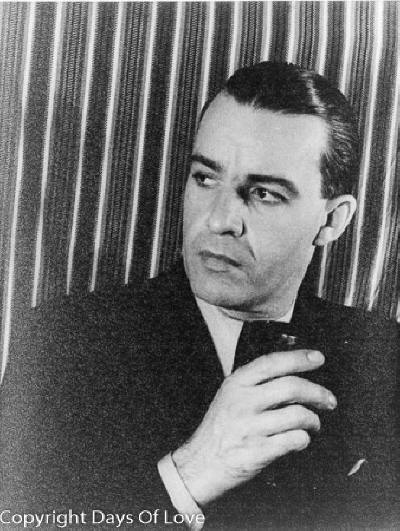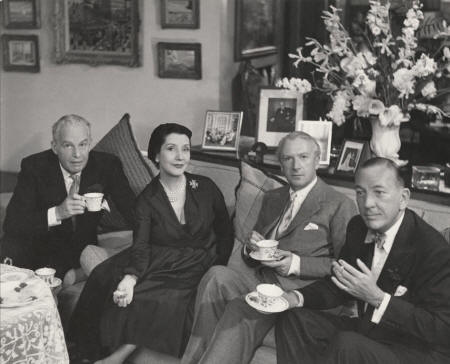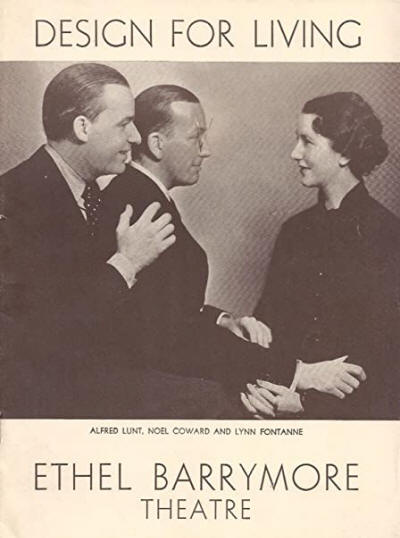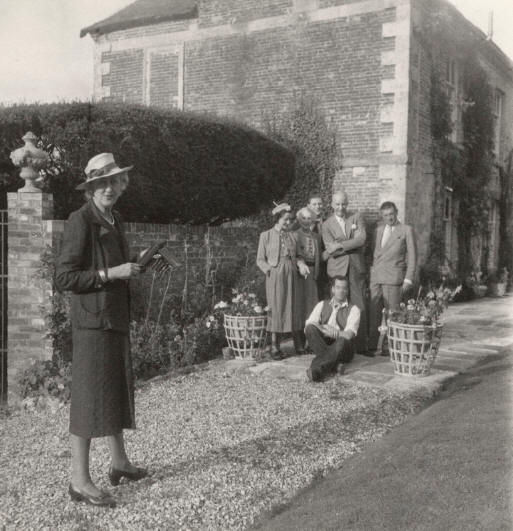

Wife Lynn Fontanne
Queer Places:
130 W 70th St, New York, NY 10023, Stati Uniti
Carroll University, 100 N East Ave, Waukesha, WI 53186, Stati Uniti
Le Cordon Bleu, 13-15 Quai André Citroën, 75015 Paris, Francia
Lunt-Fontanne Theatre, 205 W 46th St, New York, NY 10036, Stati Uniti
Ten Chimneys, S43 W31575 Depot Rd, Waukesha, WI 53189, Stati Uniti
Forest Home Cemetery, 2405 W Forest Home Ave, Milwaukee, WI 53215, Stati Uniti
 Alfred
Davis Lunt, Jr. (August 12, 1892 – August 3, 1977) was an American stage
director and actor who had a long-time professional partnership with his wife,
actress Lynn Fontanne.
Broadway's Lunt-Fontanne Theatre was named for them. Lunt was one of 20th
century Broadway's leading male stars. Many of their closest friends were
prominent members of New York's elite gay circles, particularly
Noël Coward,
Carl Van Vechten, and
Alexander Woollcott. They had
no children of their own, but served as parental figures for several
young actors, most notably the closeted
Montgomery Clift.
Alfred
Davis Lunt, Jr. (August 12, 1892 – August 3, 1977) was an American stage
director and actor who had a long-time professional partnership with his wife,
actress Lynn Fontanne.
Broadway's Lunt-Fontanne Theatre was named for them. Lunt was one of 20th
century Broadway's leading male stars. Many of their closest friends were
prominent members of New York's elite gay circles, particularly
Noël Coward,
Carl Van Vechten, and
Alexander Woollcott. They had
no children of their own, but served as parental figures for several
young actors, most notably the closeted
Montgomery Clift.
Lunt received two Tony Awards, an Academy Award nomination for Best Actor for 1931's The Guardsman and an Emmy Award for the Hallmark Hall of Fame's production of The Magnificent Yankee.
He became a star in 1919 as the buffoonish lead in Booth Tarkington's play, Clarence, but soon distinguished himself in a variety of roles. The roles ranged from the Earl of Essex in Maxwell Anderson's Elizabeth the Queen, to a song-and-dance man touring the Balkans in Robert E. Sherwood's Idiot's Delight, a megalomaniacal tycoon in S. N. Behrman's Meteor and Jupiter himself in Jean Giraudoux's Amphitryon 38. His appearances in classical drama were infrequent, but he scored successes in Shakespeare's The Taming of the Shrew and Chekhov's The Seagull (in which Lunt played Trigorin, his wife played Arkadina, and Uta Hagen made her Broadway debut in the role of Nina). He was described by director and critic Harold Clurman as "universally acclaimed the finest American actor in the generation which followed John Barrymore; the Lunts are absolute angels." [1]
Lunt was born in Milwaukee, Wisconsin in 1892[2] to Alfred D. Lunt and Harriet Washburn Briggs. With the exception of his paternal grandmother, who was of Scottish descent, his ancestors were of colonial Maine and Massachusetts stock. His father was descendant of Henry Lunt, an early settler of Newbury, Massachusetts.[3]

Alfred Lunt; Lynn Fontanne; Cecil Beaton; Noël Coward
by Paul Tanqueray
vintage bromide print, 1952
8 in. x 9 7/8 in. (204 mm x 252 mm)
Accepted in lieu of tax by H.M. Government and allocated to the Gallery, 1991
Photographs Collection
NPG x40493
![Museum of the City of New York - [Noel Coward, Alfred Lunt and Lynn Fontanne .]](http://www.elisarolle.com/images/images%20005/MNY265293.jpg)
Noel Coward, Alfred Lunt and Lynn Fontanne in Design for Living


Lady (Gladys Mary) Juliet Duff (née Lowther); Lynn Fontanne; Alfred Lunt; Simon Fleet; Chips Channon
by Cecil Beaton
bromide print, 1948
5 3/8 in. x 5 3/8 in. (138 mm x 138 mm)
Accepted in lieu of tax by H.M. Government and allocated to the Gallery, 1991
Photographs Collection
NPG x40084
.jpg)
Lunt-Fontanne Theatre, 205 W 46th St, New York, NY 10036
His mother had several New England ancestors, including Mayflower arrivals. After his father, who was in the lumber business, died in 1893, Alfred's mother remarried a Finnish-born physician, Dr. Karl Sederholm, and had another son and two daughters. The Sederholms eventually moved to Genesee Depot, in Waukesha County, Wisconsin. Lunt later attended Carroll College in nearby Waukesha, Wisconsin.
While at the Carroll Academy, Lunt made friends with Ray Bennett Weaver and Andrew Weaver, students who board at his mother and stepfather's house. The trio wrote a play entitled The Greater Love, which they intended to have staged at the college. Lunt and Ray Weaver remained close through the years after their student days and although the exact nature of their relationship was unknown, Lunt in letters referred to Weaver as "dearest boy", "honey", and "my hero of delight". Weaver remarked that as teens he and Lunt never dated women and that they "were a world unto themselves". Weaver was an English professor at the University of Michigan.
He and his wife, Lynn Fontanne, whom he married on May 26, 1922, in New York City, were the pre-eminent Broadway acting couple of American history. Secure in their public image as a happily married couple, they could play adulterers, as in Robert Sherwood's Reunion in Vienna, or as part of a menage a trois in Noël Coward's Design for Living. (The latter, written for the Lunts, was so risqué, with its theme of bisexuality and a ménage à trois, that Coward premiered it in New York, knowing it would not survive the censor in London.) The Lunts appeared together in more than twenty plays. They also were featured, posthumously, on an American postage stamp.
The couple made two films together The Guardsman (1931), in which they starred, and Stage Door Canteen (1943) in which they had cameos as themselves. In 1958 they retired from the stage.[4] They starred in several radio dramas for the Theatre Guild in the 1940s, and starred in a few television productions in the 1950s and 1960s.
In 1932 Vogue published a two-page glam shot and exposé, "Glamour and the Lunts", in which Lynn Fontanne was pictured "dazzling" in a Lavin rose-and-blue crepe tea gown, while her husband Alfred Lunt lay elegantly on a velvet settee, cigarette poised at the ready near his lips. Fontanne and Lunt were Noël Coward's closest and best friends in the United States, with whom he first charted out their collective rise to fame, stardom and celebrity. It had been suggested that the threesome relationship in Design for Living, which Coward wrote and then played with Fontanne and Lunt was a semi-autobiographical account of their own relationship.
Summers, during their days of performing on stage and their subsequent retirement years, were spent at their home "Ten Chimneys" at Genesee Depot in Lunt's home state of Wisconsin.
In 1964, Lunt and Fontanne were presented with the Presidential Medal of Freedom by President Lyndon Johnson.
Like Lynn Fontanne, Alfred Lunt is represented in the American Theatre Hall of Fame.[5]
Alfred Lunt died August 3, 1977, nine days before his 85th birthday, in Chicago from cancer. He is buried next to his wife at Forest Home Cemetery in Milwaukee.[6] He was the third person for whom the house lights were dimmed in all Broadway theaters following his death.[7]
Ten Chimneys, Lunt and Fontanne's estate in Genesee Depot, located in Waukesha County, Wisconsin, is now a house museum and resource center for theater. The Lunt-Fontanne Theatre in New York was named in honor of Lunt and his wife.
My published books: